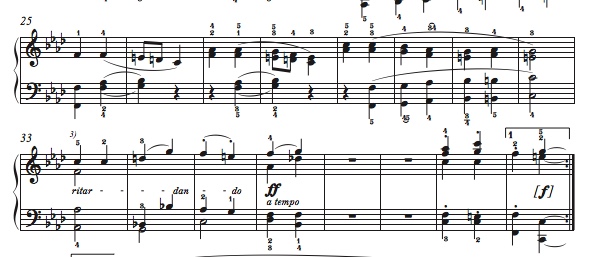Page 2 of 2
Re: Multi-bar rests
Posted: 09 Jul 2021, 03:13
by John Ruggero
teacue, I did write the manual which had a lot of personal memories of Arnstein, photos etc. but then I thought better of publishing it online. I may go back to it at some point.
I had almost forgotten about the thread about Arnstein's parts. It should give you a good idea about his methods. There are other posts regarding beaming and such on Notat.io that reference him.
OCTO wrote: ↑08 Jul 2021, 17:46
Reading two empty measures is a bit odd, what I can say.
That about sums it up! However they do sometimes occur in solo piano music. An interesting case occurs in the MS of Beethoven's Piano Sonata op. 110 (second movement). I preserved it on my edition although it already became a multi-measure rest in the first edition. In this case, after constant 4-measure phrases there is an unusual and very amusing silence in the middle of the last phrase in the section.

- op 110.2.jpeg (63.81 KiB) Viewed 2854 times
I prefer Beethoven's notation because the two measure are in a strange way not a "real silence" and four measures need to be present visually because one is supposed to hear the missing music in one's imagination:

- op 110.2 example 2.jpeg (17.92 KiB) Viewed 2854 times
Re: Multi-bar rests
Posted: 09 Jul 2021, 10:57
by David Ward
I think completely silent bars are a special case. Here is how I notated three bars of silence in 1984 notionally equivalent to three bars of music. In the event, in rehearsal we decided to shorten this silence (and thus lose the exact equivalence, but…). Score and solo cello part shown in scans. This occurs shortly after 15' 50" in the live performance recording here
https://composers-uk.com/davidward/wp-c ... ns.mp3?_=7 (solo cello Ross Pople, LFO, Edwin Roxburgh, QEH London 1985).
(BTW my notation is simpler nowadays, especially far fewer superfluous naturals &c.)
Re: Multi-bar rests
Posted: 09 Jul 2021, 11:45
by John Ruggero
David, I am not so sure about a G.P., per se, being the exceptional case. Your example does look unusual to me, and I would be concerned about the players' reaction. In any case, Gould does have an example of a multi-measure G.P. And Arnstein would have done the same to avoid writing the three G.P.'s in a row. I mentioned that the first edition of the Beethoven's op. 110 did use a multi-measure rest (without a G.P.) I think there might be better ways to handle the optional measure of rest.
Re: Multi-bar rests
Posted: 09 Jul 2021, 12:40
by teacue
@ OCTO
Thank you for your thoughts.
In the meantime I came to the conclusion that concerning the multi-bar rests I should then better stay with the established rules.
@ John Ruggero
Great to hear that you wrote the manual and I that you intend to publish it.
Good luck with this.
Indeed the posts I could find are already very valuable.
What I am trying to find at the moment is the right balance between enough and too much cues and from how many silent bars one should consider them.
I also found this opinion:
Orchestration Online wrote: It’s not necessary to pepper your score with cues after every tacet. Pro orchestra players are used to counting, and will make their own marks as needed. In fact, they will tend to ignore or become impatient with too many cues, as if you think that they’re high school band musicians.
(From
https://orchestrationonline.com/parts-assigning-cues/)
At the moment I write cues from about 10 silent bars but I have the feeling that it may be too much.
Re: Multi-bar rests
Posted: 09 Jul 2021, 13:08
by OCTO
John Ruggero wrote: ↑09 Jul 2021, 03:13
That about sums it up! However they do sometimes occur in solo piano music.
Yes, because it is a full score, equally to orchestral score.
Re: Multi-bar rests
Posted: 09 Jul 2021, 14:49
by David Ward
John Ruggero wrote: ↑09 Jul 2021, 11:45… … …Your example does look unusual to me, and I would be concerned about the players' reaction. In any case, Gould does have an example of a multi-measure G.P. And Arnstein would have done the same to avoid writing the three G.P.'s in a row.… … …
If anyone ever gets round to typesetting this piece (it's probably unlikely to be me), these are most certainly things to take serious note of, so thank you very much for pointing them out.
However, there are at present several copies of a viable set of hand written parts from 1985 and I have not been told of any uncertainty about what is meant, although the only rehearsals for the piece I've been able to attend myself were those for the first performance. For that the orchestra consisted mostly of principals from other orchestras, especially the BBCSO. The soloist, Ross Pople, was principal cellist of the BBCSO.